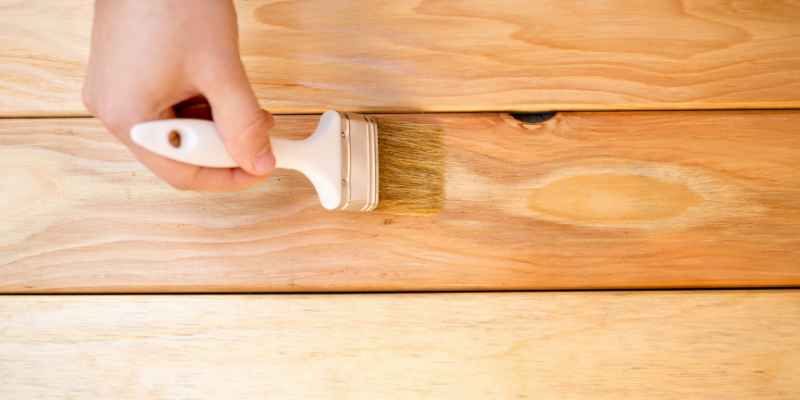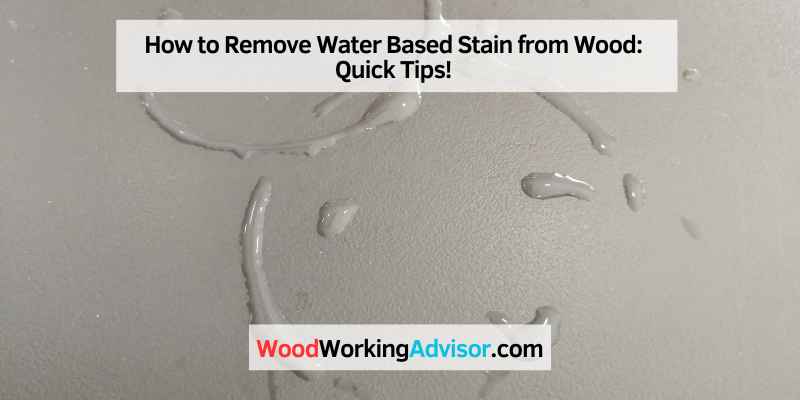To remove a water-based stain from wood, mix dish soap with warm water and gently scrub the stained area. Rinse with clean water and dry thoroughly.
Wood furniture and floors can add warmth and character to any space. However, dealing with water-based stains can be frustrating. Whether it’s a spill from a glass or a water ring from a plant pot, knowing how to effectively remove these stains is essential for maintaining the beauty of your wood surfaces.
Fortunately, with the right techniques and a little patience, you can easily restore your wood to its former glory. We’ll explore simple yet effective methods to remove water-based stains from wood, ensuring that your furniture and floors remain in top condition.
Introduction To Water Based Stains On Wood
Water-based stains on wood can be removed by sanding or using a wood stain remover. Begin by sanding the wood surface to eliminate the stain. If the stain persists, apply a wood stain remover and scrub with a brush. Wipe away the residue with a clean cloth.
Water-based stains are a popular choice for people who want to add color to their wooden furniture without changing the natural grain. Although these stains are easy to apply and can produce vibrant colors, they can also cause water stains if not applied correctly. Water stains can be unsightly and ruin the natural beauty of the wood. In this post, we will discuss how to remove water-based stains from wood.
Common Sources Of Water Stains
Water stains can occur due to various reasons. Some common sources of water stains on wood include:
- Spills from drinks or water
- Leakage from pipes or roofs
- Humidity in the air
- Placing hot or cold objects on the wood surface
Impact Of Water Stains On Wood
Water stains can have a significant impact on the look and feel of the wood. If left untreated, they can cause discoloration and weaken the wood’s structure. They can also lead to mold growth, which can be a health hazard. In addition to this, water stains can reduce the value of antique or vintage furniture. Therefore, it is essential to take immediate action to remove water stains from wood.
Removing Water-based Stains From Wood
There are several ways to remove water-based stains from wood. One effective method is to use a mixture of baking soda and water. Another method involves using a solution of vinegar and olive oil. However, the most effective way to remove water stains from wood is by using a commercial wood cleaner. It is important to follow the manufacturer’s instructions when using a wood cleaner to avoid damaging the wood surface.
In conclusion, water stains can be a common problem for those who have wooden furniture at home. By understanding the sources of water stains, their impact on wood, and how to remove them, you can keep your wooden furniture looking beautiful and in good condition for years to come.
Identifying Water Based Stains

Characteristics Of Water Stains
Water-based stains have a lighter appearance on wood surfaces.
Distinguishing Between Types Of Stains
- Water stains are usually transparent or slightly cloudy.
- They don’t penetrate deeply into the wood.
- Water stains may feel damp to the touch.
Preparation For Stain Removal
Water-based stains on wood can be tricky to remove, but with the right preparation, it can be done effectively. Here are some simple steps to follow before attempting to remove a water-based stain from wood:
Gathering Necessary Supplies
Before you begin the stain removal process, you will need to gather some supplies. Here are some things you will need:
- White vinegar
- Baking soda
- Clean cloths
- Bucket of warm water
- Gloves
- Protective eyewear
Protecting The Surrounding Area
When removing a stain from wood, it is important to protect the surrounding area. Here’s what you can do:
- Clear the area around the stained wood to prevent any accidental spills or splatters.
- Cover any nearby furniture or flooring with a plastic sheet or drop cloth to prevent any damage.
- Wear gloves and protective eyewear to prevent any contact with the stain removal products.
With these simple steps, you can prepare yourself to effectively remove water-based stains from wood. Remember to always follow safety precautions and take your time to ensure the best results.
Initial Cleaning Steps
To remove water-based stains from wood, start by gently wiping the area with a damp cloth. If the stain persists, create a paste using baking soda and water, apply it to the stain, and let it sit for a few minutes before wiping it away.
Finally, polish the wood to restore its shine.
Wiping Down The Surface
Use a clean cloth to wipe the wood surface gently.
Apply mild soap and water to the cloth.
Drying The Affected Area
Use a dry cloth to pat the area dry.
Allow the wood to air dry completely.
Homemade Solutions For Stain Removal
Discover effective homemade solutions to tackle water-based stains on wood effortlessly. Utilize simple ingredients like vinegar, baking soda, or lemon juice for eco-friendly stain removal solutions. Keep your wooden surfaces pristine and stain-free with these easy and budget-friendly DIY methods.
Vinegar And Olive Oil Mixture
Mix equal parts vinegar and olive oil to create a natural and effective solution.
Baking Soda Paste Application
Create a paste using baking soda and water to tackle stubborn stains.
Commercial Products For Stain Removal
Looking to remove water-based stains from wood? Our range of commercial stain removal products is specifically designed to tackle this issue. With their powerful formulas, you can easily eliminate stubborn stains from your wooden surfaces, restoring their original beauty. Say goodbye to unsightly marks and hello to a spotless finish with our effective stain removers.
If you have a tough water-based stain on your wooden furniture, using a commercial stain remover may be your best bet. These products are specially formulated to penetrate the wood and lift the stain without damaging the surface. However, with so many options on the market, it can be challenging to choose the right one. Here’s what you need to know when selecting a stain removal product.
Choosing The Right Product
When choosing a commercial stain remover, it’s essential to consider the type of wood you’re dealing with and the severity of the stain. Some products are designed for use on specific wood types, while others are more versatile. Look for a product that is labeled for use on your type of wood and is formulated for the type of stain you’re dealing with. For example, some products are designed to remove water-based stains, while others are better suited for oil-based stains.
Application Technique
Once you’ve chosen the right product, it’s time to apply it to the stained area. Follow the manufacturer’s instructions carefully, as application techniques can vary depending on the product. In general, you’ll want to apply the stain remover to a clean, dry surface and allow it to sit for the recommended amount of time. Then, use a clean cloth to wipe away the product, along with the stain. You may need to repeat the process several times to fully remove the stain, especially if it’s particularly stubborn.
Using a commercial stain remover can be an effective way to remove water-based stains from wood. By choosing the right product and following the correct application technique, you can restore your wooden furniture to its former glory. Just be sure to read the instructions carefully and take the necessary precautions to protect yourself and your furniture during the process.
Sanding And Refinishing
To remove water-based stain from wood, follow these simple steps:
1) Start by sanding the stained area using fine-grit sandpaper to remove the top layer.
2) Next, apply a wood bleach solution to lighten any remaining discoloration.
3) Finally, sand the area again and finish with a protective coating of stain or varnish.
This process will restore the natural beauty of your wood furniture or flooring.
When To Sand The Wood
Sanding is necessary if the stain has deeply penetrated the wood.
Use a fine-grit sandpaper to gently sand the affected area.
Ensure the surface is smooth before refinishing the wood.
Refinishing After Stain Removal
Apply a new coat of stain or sealer to the sanded area.
Let the wood dry completely before using the furniture again.
Seal the wood with a protective finish for long-lasting results.
Preventive Measures And Maintenance
To effectively remove water-based stains from wood, use a mixture of vinegar and water. Gently scrub the stained area with a soft cloth until the stain disappears. Finish by wiping the wood with a clean, damp cloth to prevent any residue buildup.
Regular maintenance helps prevent future staining.
Regular Cleaning Tips
Regular cleaning of your wooden furniture can prevent water-based stains from occurring in the first place. It’s important to dust your furniture with a dry cloth regularly to prevent dirt and debris from building up. For deeper cleaning, use a damp cloth with a mild soap solution, making sure to wipe dry immediately after.
Protective Coatings And Sealants
Applying protective coatings and sealants on your wooden furniture can help prevent water-based stains from penetrating the wood. There are many types of protective coatings and sealants available, such as polyurethane, varnish, and lacquer. Before applying any of these coatings, make sure to sand the surface of the wood to ensure proper adhesion.
Other Preventive Measures
In addition to regular cleaning and protective coatings, there are other preventive measures you can take to avoid water-based stains on your wooden furniture. These include using coasters and placemats to protect the surface from moisture and avoiding placing hot or cold items directly on the wood. It’s also a good idea to clean up spills immediately to prevent them from seeping into the wood.
By following these preventive measures and regularly maintaining your wooden furniture, you can avoid water-based stains and keep your furniture looking beautiful for years to come.
Troubleshooting Common Problems
When removing water-based stains from wood, it’s important to be prepared for potential challenges that may arise during the process. Here are some troubleshooting tips to help you effectively deal with common problems.
Dealing With Stubborn Stains
If you encounter stubborn water-based stains on wood, consider using a mixture of equal parts vinegar and water as a natural cleaning solution. Apply the solution to the stained area and gently scrub with a soft-bristled brush. Alternatively, you can also use a paste made of baking soda and water to gently buff away stubborn stains. Be cautious not to apply excessive pressure, as this could damage the wood surface.
Avoiding Damage During Stain Removal
When removing water-based stains from wood, it’s crucial to avoid causing damage to the wood surface. Prioritize using gentle cleaning methods and avoid harsh chemicals that could potentially strip or discolor the wood. Additionally, always test any cleaning solution on a small, inconspicuous area of the wood to ensure that it does not cause any adverse effects before applying it to the stained area.
Conclusion: Restoring Wood’s Natural Beauty
Restore the natural beauty of wood by effectively removing water-based stains. Discover simple techniques to bring back the original charm of your wooden surfaces without any hassle or damage. Achieve stunning results by following these step-by-step methods.
Recap Of Effective Techniques
When removing water-based stains from wood, you can use a combination of household items and gentle cleaning methods to restore its natural beauty. Start by creating a paste of baking soda and water to gently scrub the affected area. For tougher stains, consider using white vinegar or hydrogen peroxide. Always remember to test any cleaning method on a small, inconspicuous area before applying it to the entire stain. Once the stain is removed, dry the wood thoroughly and consider applying a wood polish or wax to protect and enhance its appearance.
Final Thoughts On Wood Care
Proper wood care is essential for maintaining the beauty and longevity of your furniture, floors, and other wooden items. Regular dusting, gentle cleaning, and prompt stain removal are key to preserving the natural allure of wood. Avoid harsh chemicals and abrasive cleaning tools that can damage the wood’s surface. With the right care and maintenance, your wood pieces can continue to exude their timeless elegance for years to come.

Frequently Asked Questions
How Can I Remove Water-based Stain From Wood?
To remove water-based stain from wood, start by sanding the stained area gently. Then, apply a wood stain remover using a clean cloth, following the manufacturer’s instructions. Allow the remover to sit for the recommended time, and then wipe it off.
Repeat if necessary, and finish with a wood finish product.
Can I Use Household Items To Remove Water-based Stain From Wood?
Yes, you can use household items to remove water-based stain from wood. For example, a mixture of baking soda and water can be used as a gentle abrasive to lift the stain. Additionally, vinegar or lemon juice can be effective in lightening the stain.
Always test in an inconspicuous area first.
Is It Necessary To Sand The Wood When Removing Water-based Stain?
Sanding the wood is necessary when removing water-based stain. It helps to remove the top layer of the stained wood and prepares the surface for the application of a stain remover. Sanding also smoothens the wood, ensuring an even finish when re-staining or refinishing the wood.
What Precautions Should I Take When Removing Water-based Stain From Wood?
When removing water-based stain from wood, ensure proper ventilation in the work area to avoid inhaling fumes. Use protective gloves and goggles to prevent direct contact with the stain remover. Additionally, work in a well-lit space and follow the manufacturer’s instructions for the stain removal product.
Conclusion
Removing water-based stains from wood is a manageable task that can be accomplished with the right techniques and products. By following the steps outlined in this guide, you can restore the natural beauty of your wood surfaces and enjoy a clean and flawless finish.
Embracing these methods will ensure that your wood furniture and floors remain in top condition for years to come.


